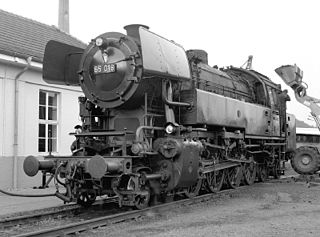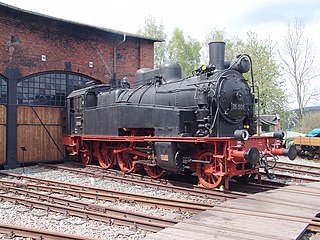
The Deutsche Reichsbahn-Gesellschaft's BR 01 steam locomotives were the first standardised (Einheitsdampflokomotive) steam express passenger locomotives built by the unified German railway system. They were of 4-6-2 "Pacific" wheel arrangement in the Whyte notation, or 2′C1′ h2 in the UIC classification. The idea of standardisation was that it would reduce maintenance costs; i.e. if a BR 01 whose engine shop was in, say, Berlin broke down in Dresden, instead of having to ship the necessary part from Berlin and take the locomotive out of service, a part from the Dresden shop could be used as all of the engines, parts, and workings were exactly the same and produced nationwide. Thus it was a "standard" product for engine shops.

The Class 62 engines were standard passenger train tank locomotives of Germany's Deutsche Reichsbahn-Gesellschaft (DRG).

The locomotives of the German DRG Class 81 were standard (Einheitsdampflokomotiven) goods train tank locomotives with the Deutsche Reichsbahn-Gesellschaft (DRG).

The German DRG Class 84s were standard goods train tank locomotives with the Deutsche Reichsbahn. A total of twelve engines were placed into service by the Reichsbahn between 1935 and 1937. The machines were given operating numbers 84 001–012. They were worked on the Müglitz Valley Railway (Müglitztalbahn) between Heidenau and Altenberg in the Ore Mountains (Erzgebirge), for which they were specially designed to negotiate tight curves. They were manufactured by the firms of Schwartzkopff and Orenstein & Koppel. One feature was that they were fitted with Schwartzkopff-Eckhardt II bogies.

The DRG Class 89.0 was a goods train tank engine of standard design built for the Deutsche Reichsbahn (DRG).

The two German DRG Class 61 steam engines were express train locomotives specifically built by Henschel for the Henschel-Wegmann train in service with the Deutsche Reichsbahn. The Henschel-Wegmann train was an initiative of the German locomotive construction industry, intended to be able to demonstrate a powerful steam locomotive-hauled train alongside the emerging express diesel multiple units, such as the Hamburg Flyer.

The German Class 03.10 engines were standard steam locomotives (Einheitsdampflokomotiven) belonging to the Deutsche Reichsbahn and designed for hauling express trains.

The German Class 99.73-76 engines were standard locomotives (Einheitslokomotiven) in service with the Deutsche Reichsbahn for Saxony's narrow gauge railways. Together with their follow-on class, the DR Class 99.77-79, they were the most powerful narrow gauge locomotives in Germany for the 750 mm track gauge.

The Prussian T 18 was the last class of tank locomotives developed for the Prussian state railways. They were originally intended for services on the island of Rügen as replacements for Class T 12 and T 10 engines. They emerged when a class of locomotive was conceived in 1912 that was to handle express and passenger trains in border areas or in shuttle services on short routes. A tank engine design with symmetrical running gear was envisaged because, unlike a tender locomotive, it could run equally fast forwards and backwards and could be operated on return journeys without having to be turned on a turntable. Its power and top speed were to be the same as those of the P 8. Robert Garbe designed this 4-6-4 (2′C2′) tank locomotive for 100 km/h with a 17-ton axle load and contracted the Vulkan Werke in Stettin to build it. It was given the designation T 18.

The steam locomotives of DB Class 65 were newly designed, German, passenger train tank locomotives, built for the Deutsche Bundesbahn after the Second World War. They were intended for suburban and commuter trains serving German cities, where they were to replace Classes 78 and 93.5. As a result, they were allocated to the locomotive depots at Darmstadt, Düsseldorf and Letmathe. Between Düsseldorf and Essen they were even used on early S-Bahn services. And between Limburg/Lahn and Wiesbaden and in the area of Darmstadt they also hauled goods trains.
The DR Class 83.10 was a newly designed (Neubaulok) steam locomotive built for the Deutsche Reichsbahn in East Germany after the Second World War and was introduced into service in 1955 and 1956.

The steam locomotives of DR Class 25.10 were passenger train locomotives built for the Deutsche Reichsbahn (DR) in East Germany after World War II.

The Rekolokomotives of DR Class 52.80 first appeared in 1960 in service with the Deutsche Reichsbahn in East Germany as extensive rebuilds of the wartime locomotives or Kriegslokomotiven of the DRB Class 52 built by Nazi Germany. This modernisation, described as 'reconstruction', extended to almost all of the components and systems on the engine.

The steam locomotives of DR Class 99.77–79 were ordered by the Deutsche Reichsbahn in East Germany after the Second World War. They were narrow gauge locomotives with a 750 mm rail gauge and were built for the narrow gauge lines in Saxony. The locomotives were largely identical to the DRG Class 99.73–76 standard locomotives (Einheitslokomotiven) built in the 1930s. To differentiate them from their predecessors they were described as Neubaulokomotiven or newly designed engines.

After the Second World War, the Deutsche Reichsbahn in East Germany had a requirement for powerful goods train locomotives with a 15-18 tonne axle load for routes in the Mittelgebirge, the mountainous areas in the south of the country. As a result, the DR Class 58.30 emerged, as part of the so-called 'reconstruction programme', based on rebuilds of the former Prussian G 12 locomotives. Between 1958 and 1962, 56 locomotives, originally from various state railways were converted at the former repair shop, RAW Zwickau.

The Mecklenburg T 4 was a German steam locomotive built for the Grand Duchy of Mecklenburg Friedrich-Franz Railway as a goods train 2-6-0T with a leading axle and three coupled axles. In 1925 it was incorporated in the renumbering plan of the Deutsche Reichsbahn as DRG Class 91.19.

The Prussian Class T 11 were passenger tank locomotives produced between 1903 and 1910 in the service of the Prussian state railways for duties on the Berlin Stadtbahn.

The Saxon Class XIV T locomotives were six-coupled tank engines operated by the Royal Saxon State Railways for mixed duties on main and branch lines. In 1925, the Deutsche Reichsbahn grouped them into their DRG Class 75.5.
The Prussian G 8.2 class of locomotives actually incorporated two different locomotive types: one was the Prussian/Oldenburg G 8.2, for which the Deutsche Reichsbahn subsequently issued follow-on orders; the other was the G 8.2 of the Lübeck-Büchen Railway.



















